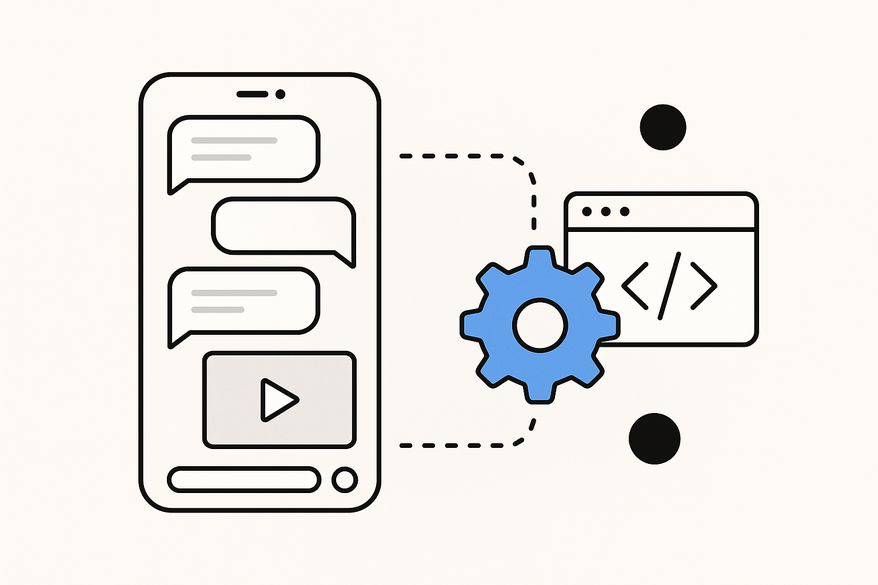Understanding Chat Story Video SDK: Definition, Features, & Benefits
Learn about chat story video SDKs, tools that merge chat interfaces with video content to boost engagement and streamline app development.

Estimated reading time: 7 minutes
Key Takeaways
- Definition: A development toolkit for integrating interactive, chat-based video experiences.
- Core Features: Chat UI widgets, video embedding, branching dialogues, and customization options.
- Benefits: Faster prototyping, improved user engagement, and simplified workflows.
- Use Cases: Entertainment, education, social media, and branded campaigns.
Table of Contents
- Understanding Chat Story Videos
- What Is a Software Development Kit (SDK)?
- SDK Functionalities & Architecture
- Benefits of a Chat Story Video SDK
- Use Cases & Applications
- Implementation – Getting Started
- Future Trends & Developments
- Conclusion & Additional Resources
Understanding Chat Story Videos
Chat story videos simulate real-time text exchanges paired with video or images within a messaging UI. Unlike traditional video formats, these narratives progress through message bubbles, creating an interactive and conversational experience.
- Message-thread driven storytelling
- Interactive choices that branch the storyline
- Familiar messaging UI for relatability
- Bite-sized scenes to boost attention spans
What Is a Software Development Kit (SDK)?
An SDK is a collection of tools, libraries, documentation, and samples that help developers integrate specific functionalities—like video playback—into their apps. A chat story video SDK extends this concept by combining chat UI components with video interaction flows.
- Prebuilt functions and UI widgets
- APIs to control features programmatically
- Comprehensive reference documentation
- Sample projects for iOS, Android, and Web
SDK Functionalities & Architecture
A robust chat story video SDK typically includes:
- Video integration tools for live or VOD content
- Message thread management with timing controls
- Branching dialogues and interactive elements
- UI customization for themes, fonts, and animations
- Native libraries (iOS, Android, Web) and API endpoints
Architecture components:
- Video playback engine
- Chat UI rendering module
- Event handling layer
- Analytics and reporting interface
Benefits of a Chat Story Video SDK
- Accelerated development: Prebuilt components reduce time-to-market.
- Ease of implementation: Single install delivers chat widgets and video modules.
- Enhanced engagement: Interactive, bite-sized videos keep users hooked.
- Simplified workflows: Non-technical teams can iterate on scripts and styling.
Use Cases & Applications
- Entertainment: Interactive fiction and chat dramas.
- Education: Gamified language quizzes and scenario-based training.
- Social Media: Short-form stories and branded engagement campaigns.
Case Study (Fictional App “ChatAdventures”): Integration led to a 20% rise in session length and doubled share-back rates within a month.
Implementation – Getting Started
Follow these steps to integrate a chat story video SDK:
- Install the SDK:
- npm install chat-story-sdk
- CocoaPods: pod 'ChatStoryVideoSDK'
- Gradle: implementation 'com.chatstory:video-sdk:1.2.0'
- Configure API keys and authentication.
- Customize UI styles, playback settings, and animations.
- Connect back-end services for story assets and analytics.
- Test message sequencing and video sync under varied conditions.
For best practices, see these companion guides:
A practical low-code example: Vidulk - Fake Text Message Story App.
Best Practices:
- Start with core chat and video features before adding branching logic.
- Optimize media files for mobile bandwidth.
- Consult official documentation and sample apps to avoid pitfalls.
Future Trends & Developments
- AI-generated storylines: NLG-driven dialogues and personalization.
- Adaptive content: Real-time metrics trigger branching scenarios.
- AR/VR extensions: Immersive chat bubbles and live audience reactions.
Conclusion & Additional Resources
We’ve explored the essentials of a chat story video SDK: definition, core features, benefits, use cases, integration steps, and future outlook. Start building your next interactive narrative today!
Further reading:
FAQ
- What platforms are supported? iOS, Android, and Web.
- Can I customize the chat UI? Yes, themes, fonts, and animations are fully configurable.
- Is live streaming supported? Most SDKs support both live and VOD content.
- How do I track engagement? Use the built-in analytics interface or integrate a third-party service.
- What languages are available? JavaScript/TypeScript, Swift/Objective-C, and Kotlin/Java.





